ASUS P5E3 Deluxe Overclocking: DDR3 Takes Front Stage
by Kris Boughton on November 20, 2007 4:00 AM EST- Posted in
- CPUs
Board Layout and Features
ASUS decided to surround the LGA775 socket on all four sides with a generous portion of copper heatpipe-pierced heatsinks, in effect thermally adjoining the memory control hub (MCH) and both sets of power MOSFET banks. The portion of the cooler located between the CPU socket and memory DIMMs is "floating" above the board with a thin layer of electrically insulating material isolating it from the components below. As is usually the case, the stock mounting solution does not provide enough clamping pressure, resulting in increased thermal resistance that usually leads to higher component temperatures than would normally be experienced. We noticed this same problem on the abit IP35-Pro, although the ASUS design did provide better overall cooling.
The P5E3 Deluxe makes excellent use of an 8-phase power delivery system, a must for any board engineered to provide the high current required when pushing a quad-core processors well beyond stock speeds. Although the MOSFETs are completely capable of operating without issue over an exceptionally large temperature range (often able to survive temperatures reaching 120C or greater) it is the Northbridge (MCH) that we really worry about. Our testing has shown the X38 chipset to be particularly sensitive to sustained load temperatures in excess of about 50-55C.
The solution to correcting the lackluster mounting pressure was almost effortless (making us wonder why ASUS didn't make the extra effort and save us the trouble). We simply removed any hardware holding the heatpipe assembly to the board, cleaned all thermal surfaces with rubbing alcohol (making sure we allowed ample time for the board to completely dry), and then remounted the unit with a fresh coating of our favorite thermal paste. This time we used small machine screws and threaded nuts in place of the plastic pushpins. This allowed us to control the loading pressure, ensuring a secure bond between the copper and the heat sources. Looking at the picture above, please note the black replacement screws used to hold everything together. In the end, the effort we invested in improving our board's cooling efficiency resulted in more than an 8C drop in measured MCH load temperatures.
As we can see, ASUS has done a wonderful job of physically locating the DIMMs as close as possible to the MCH in an effort to minimize trace lengths and maximize overclocking potential. When combined with new design features on DDR3 modules, like fully terminated data and address signal lines and 2-phase power from the motherboard, these small changes can result in rather massive increases in memory operating frequencies with low voltages.
The X38 MCH provides official support for up to 8GB of low-voltage DDR3, meaning even the most memory intensive application running atop Windows Vista 64-bit should be happy. The primary 24-pin power connector is located on the bottom edge of the board with the supplementary 8-pin EPS12V power connector being located at the top of the board near the backplane.
Intel's ICH9R, although rated at no more than about 6W when operating, is connected to the stock board cooling solution using a single heatpipe - no doubt, we discovered the Southbridge heatsink is hotter for this very reason than it otherwise would be. The board provides six SATA ports, more than enough for most overclockers. Unfortunately, ASUS decided not to include an LED POST code reader somewhere making it difficult to determine exactly what the board is doing during the POST period.
The small blue header to the bottom of the board is used for clearing the BIOS should the need arise. We were pleasantly surprised as to how gracefully the board recovered from a failed setting - one quick full-power cycle and the board defaulted to safe settings allowing us to easily enter the BIOS and correct our mistake.
One of the features separating the X38 chipset from the mainstream segment P35 MCH is the addition of PCI-E 2.0 specification compatibility. The blue slots connect direct to the MCH and each provides the full 16 lanes of bandwidth - though truthfully, we can't see the additional bandwidth really helping much as PCI-E throughput often isn't the limiting factor, especially with PCI-E 2.0 already doubling the bandwidth for 1.x. The third x16 slot (black) can operate at either x1 or x4 speeds. Two PCI slots and one additional PCI-E x1 slot round out the board's expansion capabilities.
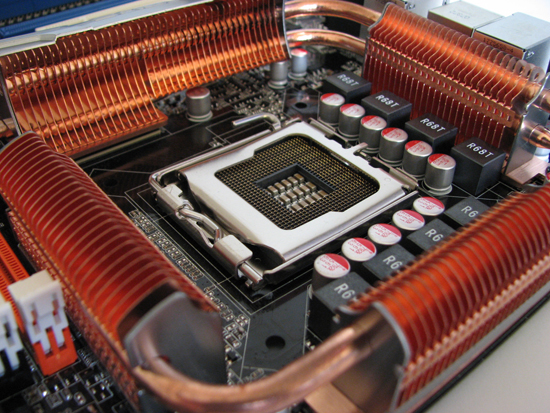 |
ASUS decided to surround the LGA775 socket on all four sides with a generous portion of copper heatpipe-pierced heatsinks, in effect thermally adjoining the memory control hub (MCH) and both sets of power MOSFET banks. The portion of the cooler located between the CPU socket and memory DIMMs is "floating" above the board with a thin layer of electrically insulating material isolating it from the components below. As is usually the case, the stock mounting solution does not provide enough clamping pressure, resulting in increased thermal resistance that usually leads to higher component temperatures than would normally be experienced. We noticed this same problem on the abit IP35-Pro, although the ASUS design did provide better overall cooling.
The P5E3 Deluxe makes excellent use of an 8-phase power delivery system, a must for any board engineered to provide the high current required when pushing a quad-core processors well beyond stock speeds. Although the MOSFETs are completely capable of operating without issue over an exceptionally large temperature range (often able to survive temperatures reaching 120C or greater) it is the Northbridge (MCH) that we really worry about. Our testing has shown the X38 chipset to be particularly sensitive to sustained load temperatures in excess of about 50-55C.
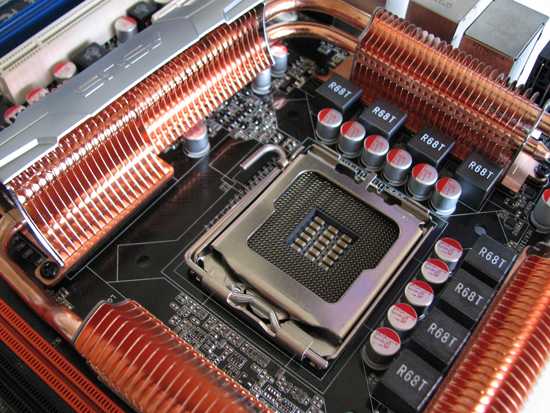 |
The solution to correcting the lackluster mounting pressure was almost effortless (making us wonder why ASUS didn't make the extra effort and save us the trouble). We simply removed any hardware holding the heatpipe assembly to the board, cleaned all thermal surfaces with rubbing alcohol (making sure we allowed ample time for the board to completely dry), and then remounted the unit with a fresh coating of our favorite thermal paste. This time we used small machine screws and threaded nuts in place of the plastic pushpins. This allowed us to control the loading pressure, ensuring a secure bond between the copper and the heat sources. Looking at the picture above, please note the black replacement screws used to hold everything together. In the end, the effort we invested in improving our board's cooling efficiency resulted in more than an 8C drop in measured MCH load temperatures.
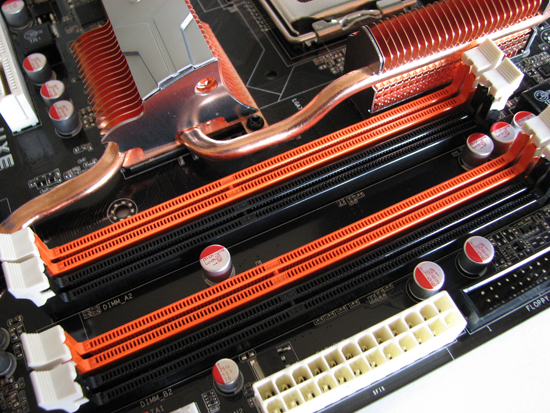 |
As we can see, ASUS has done a wonderful job of physically locating the DIMMs as close as possible to the MCH in an effort to minimize trace lengths and maximize overclocking potential. When combined with new design features on DDR3 modules, like fully terminated data and address signal lines and 2-phase power from the motherboard, these small changes can result in rather massive increases in memory operating frequencies with low voltages.
The X38 MCH provides official support for up to 8GB of low-voltage DDR3, meaning even the most memory intensive application running atop Windows Vista 64-bit should be happy. The primary 24-pin power connector is located on the bottom edge of the board with the supplementary 8-pin EPS12V power connector being located at the top of the board near the backplane.
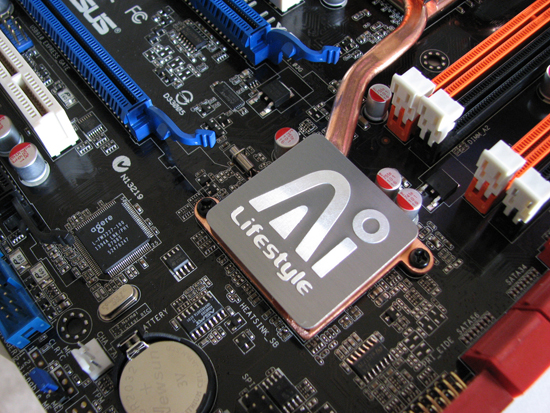 |
Intel's ICH9R, although rated at no more than about 6W when operating, is connected to the stock board cooling solution using a single heatpipe - no doubt, we discovered the Southbridge heatsink is hotter for this very reason than it otherwise would be. The board provides six SATA ports, more than enough for most overclockers. Unfortunately, ASUS decided not to include an LED POST code reader somewhere making it difficult to determine exactly what the board is doing during the POST period.
The small blue header to the bottom of the board is used for clearing the BIOS should the need arise. We were pleasantly surprised as to how gracefully the board recovered from a failed setting - one quick full-power cycle and the board defaulted to safe settings allowing us to easily enter the BIOS and correct our mistake.
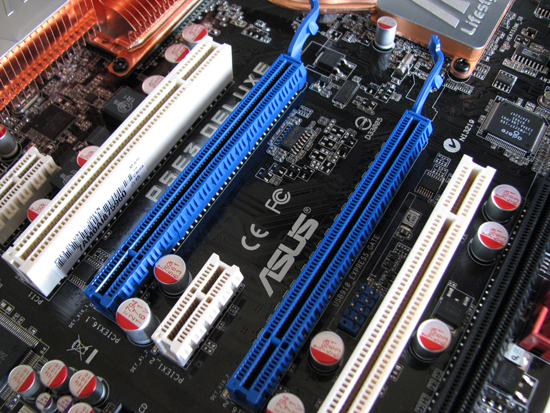 |
One of the features separating the X38 chipset from the mainstream segment P35 MCH is the addition of PCI-E 2.0 specification compatibility. The blue slots connect direct to the MCH and each provides the full 16 lanes of bandwidth - though truthfully, we can't see the additional bandwidth really helping much as PCI-E throughput often isn't the limiting factor, especially with PCI-E 2.0 already doubling the bandwidth for 1.x. The third x16 slot (black) can operate at either x1 or x4 speeds. Two PCI slots and one additional PCI-E x1 slot round out the board's expansion capabilities.










25 Comments
View All Comments
Owls - Tuesday, November 20, 2007 - link
DDR2 is hardly "inferior". When comparing 4GB of DDR3 vs 4GB of DDR2, I can build a whole new computer with what I'd have spent on DDR3. It just doesn't make sense right now no matter how you cut it.. and only having 1GB of ram now?TA152H - Tuesday, November 20, 2007 - link
I run most of my machines with 512 MB, so 1 GB is hardly a problem.There are some things you need more memory than 1 GB for.
When I see stuff like "It doesn't make sense no matter how you cut it", I instantly think you're an idiot. You're probably not, but that statement is absurd. There is always a group that the cost of the most expensive, and fastest parts, makes sense. The cost of memory is trivial compared to the cost of salaries, for example, and spending $500 to help someone work faster pays for itself very quickly.
I think the main problem is that most people do not understand that more memory does not always make things faster. I deal with this all the time.
AnnihilatorX - Tuesday, November 20, 2007 - link
Correct me if I am wrongThe increase in FPS you see going from 400x9 to 465x9 is nearly 100% due to increase in CPU frequency
The performance increase of a 465x9 RAM running at 2:1 memory divider would be less than 5% higher than a similar configuration of 465x9 with slower RAM running at lower divider ratios.
That would mean there is no sense to buy a premium DDR3 for $500 extra for what you can do with less than 5% performance sacrifice with the dirt cheap DDR2 RAM.
snarfbot - Sunday, November 25, 2007 - link
no everything you said is correct.the thing that really gets me though, is that pc6400 ddr2 is commonly capable of reaching 485mhz at lower timings. so whats so great about ddr3?
on a p35 you can easily reach the same speed with cheap memory, at cas 5, sometimes even cas 4 with good overclockable ram.
so basically the only benefit that ddr3 has going for it is the lower voltage required, and of course lower temps, not worth the premium. period.
Aivas47a - Tuesday, November 20, 2007 - link
This is one of the best, detailed overclocking guides I've ever seen. Excellent job! I'm especially glad to have the mystery of Transaction Booster, Skew, and Clock Twister in the Asus bios explained.Now, if you guys could just prepare a guide for memory subtimings, the treatise would be complete. :)
Thanks very much for this.